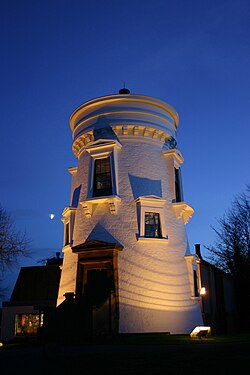Dumfries Museum: Difference between revisions
No edit summary |
No edit summary |
||
| Line 58: | Line 58: | ||
}} |
}} |
||
Dumfries Museum & Camera Obscura, located in [[Dumfries]] in [[Dumfries_and_Galloway|Dumfries & Galloway]], is the largest museum in the |
Dumfries Museum & Camera Obscura, located in [[Dumfries]] in [[Dumfries_and_Galloway|Dumfries & Galloway]], is the largest museum in the region. The museum has extensive collections relating to local and history from the pre-historic era. The museum also has the worlds oldest working [[Camera Obscura]]. Admission is free, however a small fee applies for the Camera Obscura. |
||
==Collections== |
|||
The museum's collections cover all material relating to the natural history and human pre-history of the region, from geology to dress, folk material, archaeology and early photographs. |
|||
Notable artefacts include: |
|||
* A cast of the skull of [[Robert the Bruce]] as well as femur and foot bones. |
|||
* A Bronze Age cist burial including the remains of a 35 year old man from the [[beaker people]]. |
|||
* A large collection of [[Roman]] and [[Celtic]] stone crosses and funerary monuments. |
|||
* A replica of the the first bicycle, as designed by [[Kirkpatrick Macmillan]]. |
|||
* The photographic archive of Dr [[Werner Kissling]]. |
|||
* Personal items belonging to [[Thomas Carlyle]] |
|||
==History== |
|||
Originally built as a four storey [[windmill]] on Corbelly hill the highest point in [[Maxwelltown]] in 1798, the site was purchased by Dumfries and [[Maxwellton]] Astronomical Society in 1834. Over a two year period the tower was converted into an [[Observatory]], and having received advice from polar explorer [[Sir John Ross]], a [[telescope]] was purchased from a Mr Morton of [[Kilmarnock]]. With its completion in 1836, unfortunately the observatory missed the arrival of [[Halley's comet]], however was used in this role until 1872. |
|||
The main hall of the museum was built in 1862, and housed the collections of the newly founded Dumfries and Galloway Natural History & Antiquarian Society. In 1981 a major addition of a new gallery, shop, search room and offices for curatorial staff was added. In 2011 the exterior of the windmill tower was refurbished. |
|||
==Camera Obscura== |
|||
The [[camera obscura]] is currently the oldest working example in the world, and has been in continuous operation since 1836. The instrument, based in the top level of the windmill tower, offers a complete 360° panorama of the surrounding landscape. The image is projected onto a focusing table below, and operated using a simple rope mechanism. In order to protect the instrument it is only operated during the summer months and on days when weather conditions are clear. |
|||
==Images== |
==Images== |
||
| Line 76: | Line 99: | ||
*[http://futuremuseum.co.uk/PartnerMuseums.aspx/Show/dumfries_museum_camera_obscura/ Dumfries Museum on Future Museum] |
*[http://futuremuseum.co.uk/PartnerMuseums.aspx/Show/dumfries_museum_camera_obscura/ Dumfries Museum on Future Museum] |
||
*[http://www.undiscoveredscotland.co.uk/dumfries/museum/index.html/ Dumfries Museum on Undiscovered Scotland] |
|||
Revision as of 17:11, 10 February 2012
A major contributor to this article appears to have a close connection with its subject. (February 2012) |
| Dumfries Museum and Camera Obscura | |
|---|---|
 Exterior view of the Camera Obscura | |
 | |
| General information | |
| Architectural style | Victorian and modern |
| Town or city | Dumfries |
| Country | Scotland |
| Renovated | 2011 |
Dumfries Museum & Camera Obscura, located in Dumfries in Dumfries & Galloway, is the largest museum in the region. The museum has extensive collections relating to local and history from the pre-historic era. The museum also has the worlds oldest working Camera Obscura. Admission is free, however a small fee applies for the Camera Obscura.
Collections
The museum's collections cover all material relating to the natural history and human pre-history of the region, from geology to dress, folk material, archaeology and early photographs.
Notable artefacts include:
- A cast of the skull of Robert the Bruce as well as femur and foot bones.
- A Bronze Age cist burial including the remains of a 35 year old man from the beaker people.
- A large collection of Roman and Celtic stone crosses and funerary monuments.
- A replica of the the first bicycle, as designed by Kirkpatrick Macmillan.
- The photographic archive of Dr Werner Kissling.
- Personal items belonging to Thomas Carlyle
History
Originally built as a four storey windmill on Corbelly hill the highest point in Maxwelltown in 1798, the site was purchased by Dumfries and Maxwellton Astronomical Society in 1834. Over a two year period the tower was converted into an Observatory, and having received advice from polar explorer Sir John Ross, a telescope was purchased from a Mr Morton of Kilmarnock. With its completion in 1836, unfortunately the observatory missed the arrival of Halley's comet, however was used in this role until 1872.
The main hall of the museum was built in 1862, and housed the collections of the newly founded Dumfries and Galloway Natural History & Antiquarian Society. In 1981 a major addition of a new gallery, shop, search room and offices for curatorial staff was added. In 2011 the exterior of the windmill tower was refurbished.
Camera Obscura
The camera obscura is currently the oldest working example in the world, and has been in continuous operation since 1836. The instrument, based in the top level of the windmill tower, offers a complete 360° panorama of the surrounding landscape. The image is projected onto a focusing table below, and operated using a simple rope mechanism. In order to protect the instrument it is only operated during the summer months and on days when weather conditions are clear.
Images
-
15th Century gold ring with gems
-
Celtic sculpture showing Roman influence
-
Jacobite Era Basket-Hilt sword
-
1150-750BC Gold Ring
-
Replica of the first bicycle designed by Kirkpatrick Macmillan
-
Child's Ring Roman Period
External links
- Dumfries Museum at Dumfries and Galloway Council website
